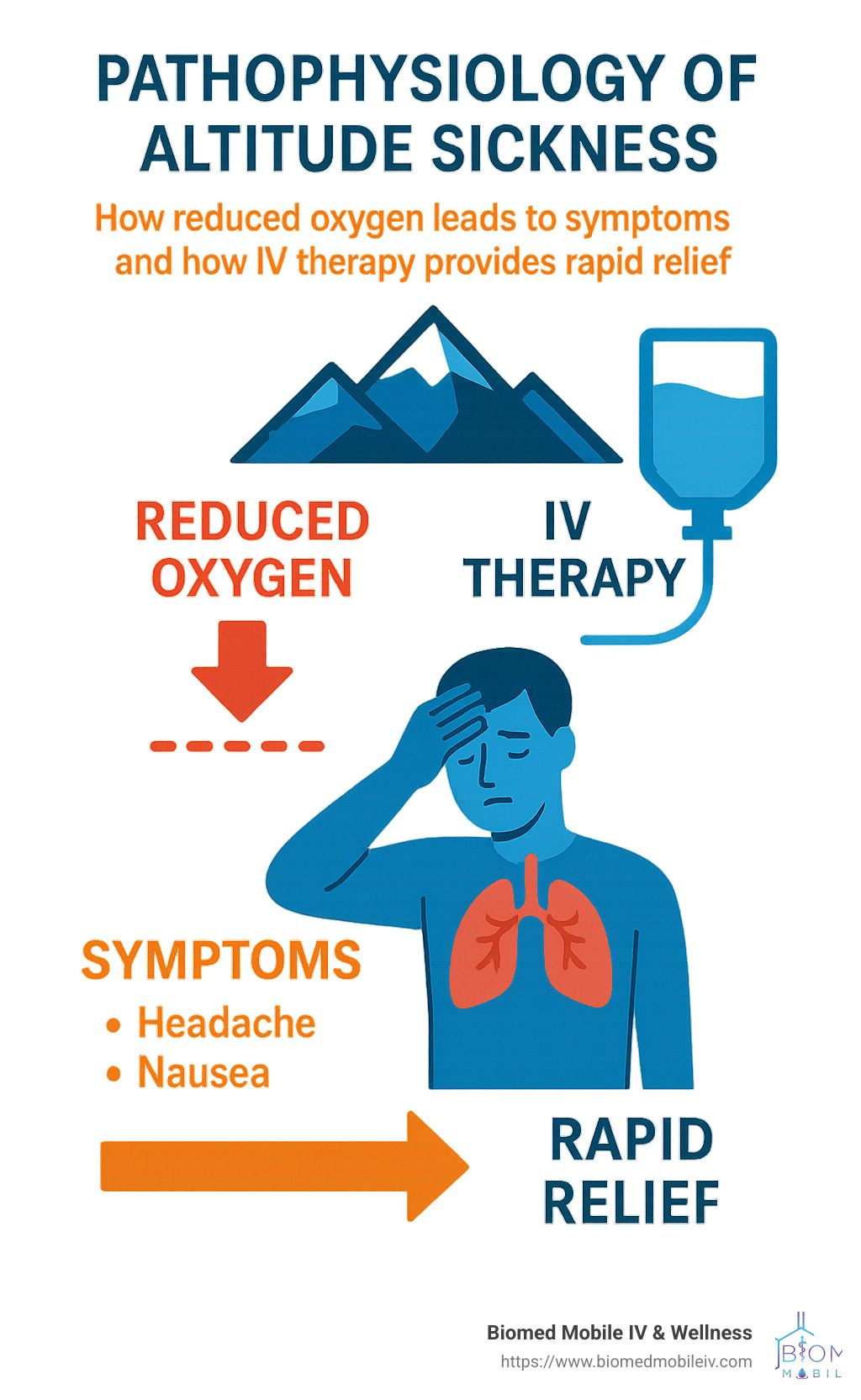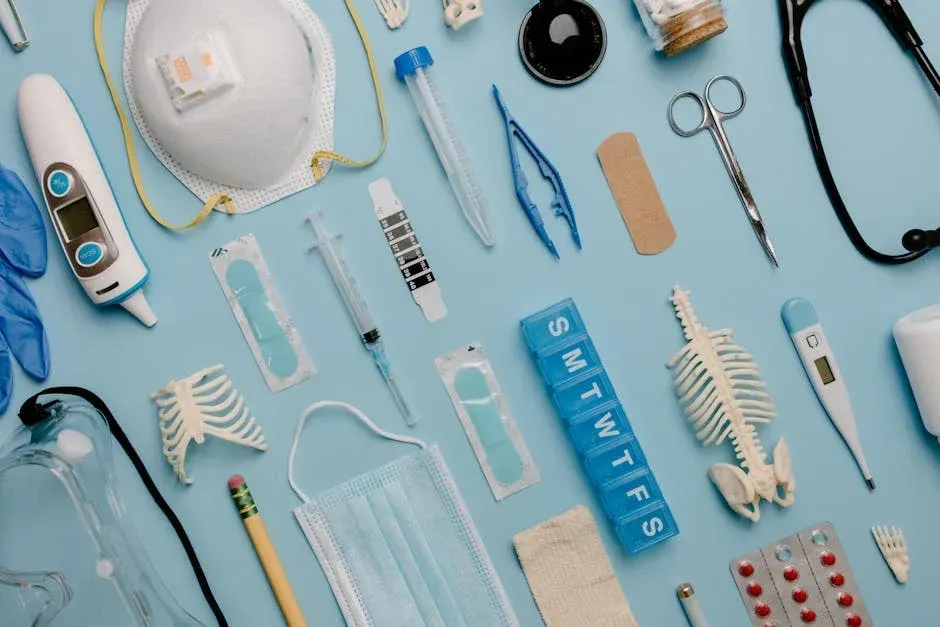Climbing High? How IV Therapy Eases Altitude Sickness
The Reality of High-Altitude Trips
Every year, thousands of visitors flock to Colorado's breathtaking mountains, eager to experience the majestic peaks and stunning views. But for many, those picture-perfect moments are quickly overshadowed by the unwelcome arrival of altitude sickness. That throbbing headache behind your eyes? The queasy feeling in your stomach? The exhaustion that makes even walking to your hotel room feel like a marathon? That's not just jet lag or dehydration—it's your body's distress signal as it struggles with the thin mountain air.
When you ascend quickly to elevations above 8,000 feet, your body simply doesn't have time to adapt to the lower air pressure and reduced oxygen levels. This condition, known as Acute Mountain Sickness (AMS), doesn't discriminate—it affects about 25% of visitors sleeping at high elevations in Colorado, regardless of your age, fitness level, or mountain experience.
"There is no reason for anyone to die from altitude illness unless they are trapped by weather or geography," notes the CDC's guidance on high-elevation travel. While most cases resolve with time and rest, why suffer through days of discomfort when relief could be just 30 minutes away?
I'm Travis Sugg, a paramedic with over a decade of experience treating altitude-related illnesses throughout Colorado's high-elevation communities. As the founder of Biomed Mobile IV & Wellness, I've personally administered hundreds of IV treatments that have helped climbers, skiers, and travelers quickly recover from altitude-related symptoms and get back to enjoying their mountain trips.
Altitude sickness IV therapy delivers fluids, electrolytes, vitamins, and medications directly into your bloodstream, providing rapid relief when you need it most.

Altitude Sickness 101: Causes, Symptoms, Risks
Ever wondered why that mountain vacation started with a splitting headache? When you venture above 8,000 feet, your body enters a different world—one with significantly less oxygen. At 10,000 feet, you're breathing air with only 69% of the oxygen you'd get at sea level. This dramatic drop is what triggers altitude sickness.
The culprit is hypoxia—when your tissues become oxygen-starved. This happens when you climb too quickly, giving your body no chance to adapt to the thinner air. As barometric pressure drops at higher elevations, each breath delivers fewer oxygen molecules to your hungry cells.
"As an encephalopathy, HACE is considered 'end stage' AMS," explains the CDC Yellow Book, highlighting how a simple headache can potentially progress to something far more serious if ignored.
Here's a surprising fact: being young and physically fit doesn't protect you—it might actually increase your risk! That's because fitter folks often push harder and ascend faster, giving their bodies less time to adjust. That marathon training won't help you here!
Most people develop symptoms within 2–12 hours after reaching high elevation, with symptoms typically resolving within 48 hours if you don't climb higher. But why suffer through two days of misery when treatments like altitude sickness IV therapy can bring relief in under an hour?
Recognizing Trouble at 8,000 ft
If you've ever had a hangover, you already know what altitude sickness feels like—minus the fun night before. Doctors use the Lake Louise Score to diagnose Acute Mountain Sickness (AMS) based on these telltale signs:
That persistent, throbbing headache that worsens when you move. The tossing and turning at night despite feeling exhausted. The room that won't stop spinning. The lunch you suddenly have no interest in eating. The unusual fatigue that makes climbing a flight of stairs feel like scaling Everest.
"AMS feels exactly like a bad hangover," notes the Institute For Altitude Medicine, which can make it tricky to distinguish from actual dehydration or exhaustion.
What makes altitude sickness particularly sneaky is that symptoms often worsen at night. While you sleep, your breathing naturally slows down, further reducing already limited oxygen levels—creating a perfect storm for middle-of-the-night misery.
When Mild Becomes Dangerous
While most altitude sickness cases resolve with time and proper care, it's crucial to recognize when things are taking a serious turn. The two severe forms—High-Altitude Cerebral Edema (HACE) and High-Altitude Pulmonary Edema (HAPE)—are rare but potentially fatal.
HACE is essentially brain swelling caused by fluid leakage. Early warning signs include confusion, inability to walk straight, severe headache that medications won't touch, and excessive drowsiness. Without immediate treatment, this can progress to coma.
HAPE involves fluid buildup in the lungs and presents with extreme fatigue, breathlessness even when resting, and a cough that may produce pink, frothy sputum. You might notice bluish lips and fingernails (cyanosis)—a clear emergency signal.
The good news? HAPE affects roughly 1 in 10,000 Colorado skiers, while HACE is "almost never seen below 13,000 ft in Colorado resorts," according to altitude medicine experts. But for those venturing to Colorado's highest peaks (like those majestic 14,000+ foot mountains), the risk increases to about 1 in 100 climbers.
Despite their rarity, both conditions develop rapidly and require immediate medical attention. The fitness myth strikes again here—being in excellent shape provides no protection against these serious complications.
The truth is, altitude sickness IV therapy isn't just about comfort—it's about safety. By addressing symptoms early with proper hydration, electrolytes, and medications delivered directly to your bloodstream, you can often prevent mild discomfort from progressing to something more dangerous.
Remember: there's no badge of honor for suffering through preventable symptoms when safe, effective relief is available.
Altitude Sickness IV Therapy: How It Works & What's Inside
When you're gasping for breath at 10,000 feet with a pounding headache, the last thing you want is to wait hours for relief. This is where altitude sickness IV therapy shines – delivering rapid comfort when you need it most.
Think of altitude sickness IV therapy as a superhighway directly to your bloodstream, bypassing the slow, winding road of your digestive system. When you're at high elevation, your body faces three major challenges: dehydration, electrolyte imbalance, and oxidative stress. IV therapy addresses all three simultaneously.
"The beauty of IV therapy is that it works almost immediately," explains Travis Sugg, founder of Biomed Mobile IV & Wellness. "While oral medications might take hours to absorb – especially when you're nauseated – an IV delivers 100% of its nutrients directly to your cells within minutes."
This immediate absorption is particularly valuable when altitude sickness has you feeling miserable. Research shows that altitude sickness IV therapy can deliver noticeable symptom relief in as little as 30 minutes, compared to the hours you might spend waiting for pills to kick in.
At higher elevations, your body works overtime – breathing faster, pumping blood harder, and changing how your kidneys function. All this extra effort can quickly lead to dehydration and mineral depletion. An IV delivers precisely what your body needs to restore balance and help you feel human again.
Key Ingredients in an Altitude Sickness IV
The magic of an effective altitude sickness IV lies in its carefully formulated blend of fluids, electrolytes, vitamins, and medications custom to your specific symptoms.

Your typical altitude sickness IV contains a base fluid solution – either normal saline or Lactated Ringer's. Many medical providers prefer Lactated Ringer's for altitude issues because it more closely matches your blood's natural composition and helps prevent fluid overload when you're already breathing harder at elevation.
To this base, we add a powerful cocktail of vitamins and minerals:
B Complex Vitamins work as your body's energy factory managers, helping convert food into usable fuel. When you're struggling at altitude, these vitamins support your nervous system and boost energy production when you need it most.
Extra B12 gets added because it helps your body produce more red blood cells – crucial when you're trying to transport limited oxygen more efficiently through your bloodstream.
Vitamin C works overtime as an antioxidant warrior, fighting the increased oxidative stress your body experiences at high altitudes. It's like sending in reinforcements when your cells are under siege.
Magnesium is your muscle and nerve support system. It helps calm those throbbing headaches and muscle cramps that often accompany altitude sickness. Many people are already magnesium-deficient, and altitude stress can make this worse.
Zinc boosts your immune function – helpful since your immune system can be temporarily compromised at higher elevations.
Glutathione is often called the "master antioxidant," and for good reason. This powerful compound helps neutralize the free radicals that multiply during altitude-related stress, protecting your cells from damage.
For those with more severe symptoms, we can add targeted medications:
Ondansetron (Zofran) quickly quiets the nausea and vomiting that can make altitude sickness so miserable. When you can't keep food or pills down, this medication delivered directly through the IV can be a game-changer.
Ketorolac (Toradol) tackles those splitting altitude headaches without irritating your stomach – a common side effect when taking oral pain relievers, especially at altitude.
Many altitude sickness IV treatments use the Myers' Cocktail as their foundation. This blend, developed by Dr. John Myers, wasn't specifically created for altitude issues but has proven remarkably effective for them. It contains many of the essential nutrients your oxygen-starved body craves at elevation.
How Fast Will You Feel Better?
The speed of relief is where altitude sickness IV therapy truly shines. While individual responses vary, most people report feeling significantly better within 30 minutes of starting treatment – a dramatic improvement over other options.
When you request a mobile IV service in Colorado, a qualified provider typically arrives at your location within 60-90 minutes. The actual IV infusion takes about 30-45 minutes to administer. That means you could go from miserable to much improved in just about 2 hours from when you make the call.
Compare this to untreated altitude sickness, which studies show lasts an average of 16 hours but can drag on for up to 36 hours. That's potentially a day and a half of your vacation or business trip wasted feeling terrible!
"I've had clients who were considering cutting their ski trip short because they felt so awful," shares Travis from Biomed Mobile IV & Wellness. "After a 45-minute altitude sickness IV treatment in their hotel room, they were able to enjoy the rest of their stay without missing a single run."
When you're investing time and money in a Colorado mountain trip, why lose precious days to preventable suffering? Altitude sickness IV therapy can be the difference between a memorable trip for all the right reasons – or all the wrong ones.
IV vs Other Treatments: Speed, Efficacy, Safety
When you're suffering from altitude sickness, you want relief—and fast. But with several treatment options available, how do you know which one is right for your situation? Let's compare altitude sickness IV therapy with other common treatments to help you make an informed decision.
Descent remains the gold standard treatment for all forms of altitude illness. As the CDC plainly states, "There is no reason for anyone to die from altitude illness unless they are trapped by weather or geography." Going down just 1,600–3,300 feet often resolves symptoms within hours.
But let's be honest—immediately heading down the mountain isn't always practical or necessary for milder cases. Maybe you've just checked into your hotel after a long journey, or perhaps you're in the middle of an important business conference. This is precisely where other treatments, including altitude sickness IV therapy, become valuable alternatives.
The Treatment Spectrum
Descent works because it directly addresses the core problem—less oxygen at higher elevations. It's extremely safe with no side effects, and symptoms typically improve within hours. The downside? It might disrupt your travel plans or be impossible due to weather conditions or time of day.
Supplemental Oxygen delivers quick relief while you're using it. Headache symptoms often improve within about 30 minutes, making it a good option for temporary relief. However, you need special equipment, and the relief only lasts while you're actively using it.
Oral Medications come in several varieties:
Acetazolamide (Diamox) is 75% effective for prevention but less helpful once symptoms develop. It takes 12-24 hours for full effect and causes side effects like tingling extremities and altered taste. It's also not an option if you have a sulfa allergy.
Dexamethasone works well for moderate to severe cases, with effects beginning in 2-4 hours. While safe for short-term use, it masks symptoms rather than helping your body acclimatize—think of it as a temporary fix, not a cure.
Ibuprofen can help with altitude headaches within 1-2 hours but only addresses the pain component of altitude sickness. Plus, it can upset your stomach—not ideal when you're already feeling nauseated.
Altitude Sickness IV Therapy delivers rapid relief, with symptoms improving within 30 minutes in many cases. It's highly effective for mild to moderate AMS because it bypasses your digestive system, delivering hydration, electrolytes, and medications directly into your bloodstream. This is particularly valuable when nausea makes it hard to keep oral medications down.
"IV therapy bypasses the gastrointestinal system for maximum absorption of nutrients," explains medical literature, highlighting why it works faster than pills, especially when your stomach is upset.
Portable Hyperbaric Chambers (sometimes called Gamow Bags) simulate descent by increasing the pressure around you, effectively "bringing you down" 5,000-6,000 feet without actually moving. Relief comes within 1-2 hours, but these specialized devices aren't widely available to the average traveler.
When to Choose IV Therapy
Altitude sickness IV therapy shines in specific scenarios:
- When you're experiencing nausea that makes oral medications difficult to keep down
- When you need fast relief but can't descend immediately
- When dehydration is compounding your symptoms (common at altitude)
- When you want to continue your trip without losing days to discomfort
Travis, a Colorado visitor from Florida, shared: "After suffering through my first day in Breckenridge with a pounding headache and nausea, I called for an altitude sickness IV. Within an hour of treatment, I felt like myself again and didn't waste another minute of my ski vacation."
Safety Considerations
For mild to moderate altitude sickness, altitude sickness IV therapy is very safe when administered by trained professionals. At Biomed Mobile IV & Wellness, our treatments are provided by experienced paramedics and nurses who understand the unique challenges of altitude-related illness.
However, it's crucial to understand that for severe altitude illness (HACE or HAPE), altitude sickness IV therapy should complement—not replace—immediate descent and emergency medical care. These serious conditions are medical emergencies requiring comprehensive intervention.
If you're experiencing confusion, difficulty walking in a straight line, severe shortness of breath, or a bluish tint to your lips or fingernails, seek emergency medical care immediately.
The Bottom Line
Each treatment option has its place in managing altitude sickness. While descent remains the definitive solution, altitude sickness IV therapy offers a compelling combination of speed, effectiveness, and convenience that makes it particularly valuable for visitors to Colorado's high-elevation destinations.
By understanding all your options, you can make the best choice for your specific situation and get back to enjoying the magnificent mountain views rather than suffering in your hotel room.
Prevention & Acclimatization Guide
The best approach to altitude sickness is prevention. By following established acclimatization protocols and preparing your body properly, you can significantly reduce your risk of developing symptoms and enjoy your time in Colorado's beautiful mountains.
Gradual Ascent: The Golden Rule
Your body needs time to adjust to thinner air. Think of acclimatization like introducing yourself to a new friend—rushing things rarely works out well.
The CDC offers some practical advice that I've seen work wonders with my patients:
Avoid jumping straight from sea level to sleeping above 9,000 ft in a single day. Your body will thank you for the gradual introduction.
Once you're above 9,000 ft, be gentle with yourself—limit sleeping elevation gains to no more than 1,600 ft per day.
For every 3,300 ft of elevation gain, give yourself an extra day to adjust. Your mountain trip isn't going anywhere!
For visitors flying into Denver from coastal areas, consider spending your first night in the Mile High City (5,280 ft) before heading up to mountain towns like Breckenridge or Telluride. This simple step can make a world of difference.
As the CDC wisely notes, "These reasonable recommendations can still be too fast for some travelers and annoyingly slow for others." We're all unique in how we respond to altitude—there's no one-size-fits-all approach.
Hydration Strategy
At altitude, you're losing moisture with every breath. The dry mountain air combined with faster breathing means you need significantly more fluids than usual.
Start "pre-hydrating" before your trip even begins. Your body should be well-hydrated before you start ascending—think of it as filling your tank before a long drive.
Aim for 3-4 liters of water daily while at altitude. A good rule of thumb? Your urine should be pale yellow, not dark amber.
Don't just drink plain water—include electrolyte beverages to replace the minerals you're losing through increased respiration and potential sweating.
Many of my clients have found that pre-trip altitude sickness IV hydration gives them a significant head start on prevention. By optimizing your fluid and nutrient levels before you ever set foot on the mountain, you're setting yourself up for success.
As medical research confirms, "Hydrating effectively improves the ability of red blood cells to pick up oxygen in the lungs, which is essential for breathing at high altitudes." When every breath counts, proper hydration makes each one more efficient.
Nutritional Considerations
What you eat can dramatically impact how well you handle altitude. Your body's fuel needs change when oxygen is limited.
Accept carbs. While at altitude, increase your carbohydrate intake to about 70% of your calories. Your body processes carbs with less oxygen than fats or proteins—it's like switching to a more efficient fuel when resources are scarce.
Pack iron-rich foods in your diet before your trip. Iron is crucial for creating red blood cells, your oxygen-carrying superheroes.
Load up on colorful fruits and vegetables. Their antioxidants help combat the increased oxidative stress your body experiences at altitude—like having extra firefighters on hand when there's a higher risk of fires.
I often recommend blueberries, strawberries, and dark leafy greens to my clients planning high-altitude trips. These foods provide natural protection against the cellular stress that comes with lower oxygen environments.
Medications for Prevention
For some travelers—especially those with a history of altitude sickness or when a gradual ascent just isn't possible—preventive medications can be extremely helpful.
Acetazolamide (Diamox) is the gold standard. Starting 24 hours before ascent at 125 mg twice daily can give your body a head start on acclimatization. It works by making your blood slightly more acidic, which tricks your body into breathing faster and deeper—exactly what you need at altitude.
Dexamethasone is powerful but typically reserved for emergency situations or unavoidable rapid ascents. It's the big gun we don't pull out unless necessary.
Ibuprofen has shown promise in studies, with 600 mg taken three times daily starting 6 hours before ascent potentially preventing altitude headaches.
Always talk with your healthcare provider before taking these medications. They're not right for everyone, and the side effects can sometimes mimic altitude sickness itself—talk about confusing!
Lifestyle Factors
The choices you make at altitude can either help or hinder your body's adjustment process.
Skip the celebratory cocktail—at least for the first 48 hours at altitude. Alcohol causes respiratory depression (the last thing you need when oxygen is already limited), promotes dehydration, and can mask early symptoms of altitude sickness. That sunset toast will be just as beautiful on day three.
If you're a coffee drinker, maintain your normal caffeine intake. Going cold turkey at altitude can trigger withdrawal headaches that mimic altitude sickness. I've seen many clients mistakenly attribute their caffeine withdrawal headache to altitude problems.
Avoid sleep aids that depress your breathing. At altitude, your breathing naturally slows during sleep, further reducing oxygen levels. Adding medications that slow respiration can make this much worse.
Take it easy physically for the first 48 hours. Light exercise is fine, but save the summit attempt or personal record for later in your trip when your body has had time to adjust.
Pre-Altitude IV Hydration
An increasingly popular approach I've seen work wonders for my clients is receiving altitude sickness IV hydration before ascending. This ensures your body starts its high-altitude journey fully hydrated and nutrient-optimized.
At Biomed Mobile IV & Wellness, we offer specialized pre-altitude IV formulations that can be administered at your hotel, home, or other convenient location before you head up to higher elevations. Think of it as giving your body a running start before the uphill climb.
Our pre-altitude IVs typically include a carefully balanced combination of fluids, electrolytes, B vitamins, vitamin C, and minerals designed to prepare your body for the physiological challenges ahead. Many clients report that this proactive approach significantly reduces their chances of developing symptoms or decreases their severity if they do occur.
The convenience of having this treatment come to you means one less thing to worry about as you prepare for your mountain trip. You can relax in your accommodation while we help prepare your body for the elevation change ahead.
Getting Help: Mobile IV, Red Flags, FAQs
When prevention isn't enough and you find yourself experiencing altitude sickness symptoms, knowing when and how to seek help is crucial. Mobile altitude sickness IV therapy offers a convenient solution that brings professional medical care directly to you.

Who Should Request an Altitude Sickness IV On-Demand
You might be wondering if altitude sickness IV therapy is right for your situation. The answer is yes if you're among several groups who benefit most from this service.
Hikers and climbers often find themselves caught between a rock and a hard place—quite literally—when symptoms hit after a challenging ascent. Rather than cutting your trip short, IV therapy can provide quick relief so you can continue safely.
For skiers and snowboarders who've traveled far for that perfect powder day, there's nothing worse than spending it in bed with a pounding headache. Many visitors to Colorado's ski resorts develop symptoms within their first 24 hours—precisely when they're most excited to hit the slopes.
Business travelers visiting high-altitude cities like Denver face a different challenge. When you're expected to perform at your professional best, the brain fog and fatigue of altitude sickness can derail important meetings and presentations.
If you have a history of altitude sensitivity, you're likely all too familiar with how quickly symptoms can develop. Being proactive with IV therapy can help you stay ahead of severe symptoms.
And for visitors with tight schedules who simply can't afford to lose precious vacation days to acclimatization, IV therapy offers a time-efficient solution.
"Getting an IV was a game-changer for our ski trip," one recent visitor to Breckenridge told us. "Instead of spending two days feeling miserable in our rental, we were back on the mountain by afternoon."
The beauty of mobile services is that treatment comes to you. Whether you're in a Denver hotel room, a vacation rental in Breckenridge, or even at a trailhead in Boulder, services like Biomed Mobile IV & Wellness will meet you where you are.
The process couldn't be simpler: make a call, and a licensed paramedic arrives at your location, assesses your symptoms and vital signs, administers the IV over 30-45 minutes, and you're free to continue your day immediately afterward. No waiting rooms, no driving while feeling unwell.
When to Seek Emergency Care
While altitude sickness IV therapy works wonders for mild to moderate symptoms, it's crucial to recognize when the situation requires emergency medical attention instead.
Don't hesitate to call 911 if you or someone in your group shows any of these warning signs:
- Difficulty walking in a straight line (ataxia)
- Severe breathing problems even when resting
- Confusion or altered mental status
- Chest pain or tightness
- Coughing up frothy or pink-tinged fluid
- Bluish discoloration of lips or fingernails
- Very low oxygen levels (below 75% if measured)
- Loss of consciousness
These symptoms may indicate progression to High Altitude Cerebral Edema (HACE) or High Altitude Pulmonary Edema (HAPE)—both life-threatening conditions requiring immediate descent and emergency medical intervention.
As one experienced mountain guide puts it, "In the mountains, there's a fine line between feeling rough and being in real danger. When in doubt, always err on the side of caution."
The CDC warns that "as an encephalopathy, HACE is considered 'end stage' AMS," highlighting why early intervention is so important. Don't try to tough it out when these serious symptoms appear.
Quick Answers to Top Questions
You probably have some questions about altitude sickness IV therapy. Let me address the most common ones I hear from visitors to Colorado's high country.
"How long will I feel bad without treatment?" Without intervention, mild to moderate symptoms typically hang around for 24-48 hours while your body slowly adjusts. With IV therapy, many people feel relief beginning within just 30 minutes, with significant improvement in 1-2 hours. As one recent client told me, "I went from thinking my vacation was ruined to being back on the slopes after lunch."
"Can I get IV therapy if I'm taking medications?" In most cases, absolutely yes. Just be sure to tell your provider about everything you're taking—prescription medications, over-the-counter drugs, and supplements. Most common medications don't interact with the components in altitude sickness IV formulations, but your provider may need to make adjustments based on your specific situation.
"Will my insurance cover this?" Currently, most insurance plans don't cover elective IV therapy for altitude sickness. However, when you consider the cost of a lost day of vacation time, expensive lift tickets, or missing an important business meeting, many find the out-of-pocket expense well worth it.
"Is this safe for my child?" Yes, children can receive IV therapy with appropriate adjustments to the formula and fluid volume based on their age and weight. In fact, kids can be more susceptible to altitude sickness because they may not recognize or clearly communicate their symptoms early on.
"Does it hurt?" Most patients experience only a brief pinch during the initial needle insertion. Our paramedics at Biomed Mobile IV & Wellness are highly skilled at achieving comfortable IV access, especially with nervous patients. The relief provided far outweighs the momentary discomfort—I promise!
"How soon after arriving at altitude should I consider treatment?" There's no need to suffer unnecessarily. If you're experiencing symptoms that interfere with your activities or comfort, don't wait it out. Early intervention often prevents symptoms from worsening and helps you enjoy your time at altitude sooner.
"What about chronic medical conditions?" Many people with chronic conditions can safely receive altitude sickness IV therapy. However, certain conditions like congestive heart failure, severe kidney disease, or uncontrolled hypertension may require modification of the IV formula or might mean IV therapy isn't the right choice. Always share your complete medical history with your provider.
One final thought: while altitude sickness IV therapy provides rapid relief, it works best as part of a comprehensive approach to altitude adjustment that includes proper hydration, moderate activity, and adequate rest. Your provider can offer personalized advice based on your specific situation and symptoms.
Conclusion
Colorado's breathtaking mountains deserve to be experienced fully, not through the fog of altitude sickness. With modern solutions like altitude sickness IV therapy, there's no need to endure days of throbbing headaches, persistent nausea, and bone-deep fatigue while your body slowly adjusts to the elevation.
The science speaks for itself: delivering fluids, electrolytes, vitamins, and targeted medications directly into your bloodstream provides the fastest relief for altitude sickness symptoms. While gradual acclimatization remains the gold standard for prevention, altitude sickness IV therapy offers a powerful solution when symptoms strike unexpectedly.
I've personally helped countless visitors and residents throughout Colorado's Front Range quickly overcome altitude challenges and get back to enjoying everything our beautiful state has to offer. Our mobile service brings professional, paramedic-administered IV therapy directly to you—whether you're in a Denver hotel room, a Boulder vacation rental, or anywhere across the communities we serve in Colorado.
Remember these key points as you plan your high-altitude trip:
Altitude sickness can affect anyone—yes, even the fittest marathon runner or the youngest member of your family. Your physical condition doesn't make you immune.
Prevention through gradual ascent and proper hydration will always be your best first line of defense. Your body needs time to adjust to the thinner air.
Early intervention with altitude sickness IV therapy can dramatically shorten your recovery time from days to hours. Why lose precious vacation time when relief is just a phone call away?
Severe symptoms require immediate medical attention and descent. Some things shouldn't be waited out, and serious altitude illness is one of them.
Mobile IV services offer the convenience of treatment in your hotel room or rental property without compromising on professional care.
Don't let altitude sickness derail your Colorado trip. With proper planning, smart prevention strategies, and knowing that effective treatment is just a phone call away, you can confidently explore our high-altitude paradise with peace of mind.
For more information about our altitude sickness IV therapy services or to schedule an appointment, visit our altitude sickness treatment page or call us directly. We're here to help you breathe easier and enjoy every moment of your time in the mountains.



